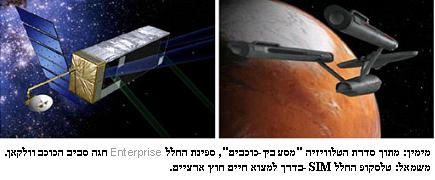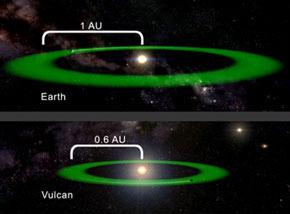The SIM space telescope will search for terrestrial planets in the Eridani 40 A system, where Dr. Spock, the hero of the "Star Trek" series, may have come from?

Will science fiction become exact science? Astronomers from NASA's Jet Propulsion Laboratory have recently concluded that the future space telescope for searching for planets - SIM PlanetQuest, will be able to discover a planet that resembles Earth in its features, if one is found in the star system Aridani 40, a system familiar to fans of the TV series "Star Trek" called "Vulcan". Eridani 40 is a three-star system 16 light-years away from Earth and contains a K-type red-orange dwarf, a star slightly smaller and colder than our Sun, known as Eridani 40 A, around which the planet "Vulcan" is said to orbit.
When the astronomer Dr. Angel Tanner thought of the idea that the SIM space telescope could discover the star Vulcan, two questions came to her: could a planet orbit around Eridani 40 A? And will the SIM space telescope be able to discover such a planet? To answer the questions, she consulted the theorist Dr. Shane Raymond from the University of Boulder, Colorado, and he for his part answered, "Since the three stars in the Eridani 40 system are very far from each other (hundreds of astronomical units), I see no reason why a star similar in mass to Earth would not will be able to circle around the central star, Eridani 40 A".
If life is possible on the planet Vulcan, its orbit around the central star must be located at the right point to create favorable conditions for the existence of liquid water on the surface of the planet. Water is an essential ingredient for creating organisms that can exist for a long time. For Eridani 40 A, this point or "zone of life", is 0.6 AU from the central star, which means that Vulcan will celebrate its birthday every six months.
The instrumentation in the SIM space telescope is so precise that it can calculate from the Earth the thickness of a coin placed on the Moon. Using mathematical models based on Newton's laws, Dr. Tanner concluded that SIM would be able to clearly determine if there is an Earth-mass star in an orbit with a habitable zone around Eridani 40 A, and also determine its orbit.

The progress is exciting, since the beginning of the TPF (Terrestrial Planet Finder mission) project to search for planets, which is planned to be launched after SIM, not only will it be able to bring a photograph of the planet, it will also look for basic data for the existence of life, such as methane gas and ozone.
When Dr. Tanner was asked, what would life be like on the planet "Vulcan"? Her guess was that they would be pale. "A K-type dwarf directs its light at a wavelength that is almost equal to the wavelength coming from our sun, so I think it might not be easy to sunbathe there," she says.
Dr. Tanner's imaging results have already been submitted for publication in the ASP (Astronomical Society of the Pacific) organization.

3 תגובות
What a beauty